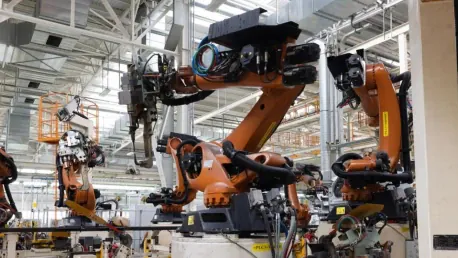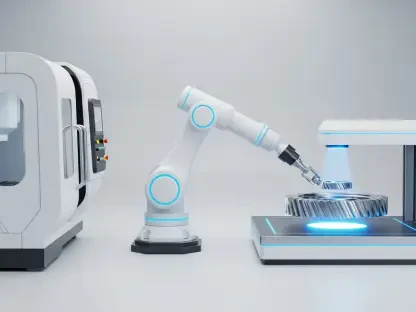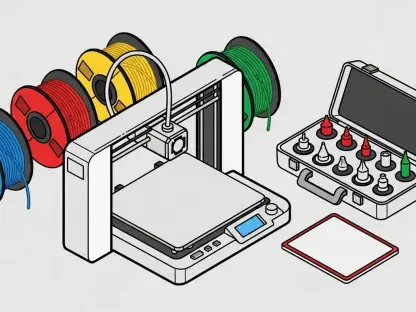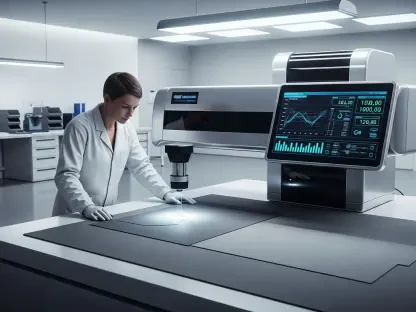The increasing integration of robotic systems in industrial and manufacturing environments has revolutionized productivity and efficiency. However, this technological advancement comes with significant cybersecurity challenges. As the market for robotic work cells is projected to grow substantially, the urgency to enhance cybersecurity measures for these systems cannot be overstated. This article delves into the prevalent challenges, current state, and best practices for mitigating cybersecurity threats targeting industrial robots.
Understanding the Current State of Robot Cybersecurity
The Growing Market and Its Vulnerabilities
Robotic systems are becoming indispensable in modern manufacturing, with the market expected to reach $12.8 billion by 2034. Despite their benefits, these systems are fraught with cybersecurity vulnerabilities. A notable incident involving a major automotive manufacturer highlights the severity of these threats. Hackers exploited weaknesses in the robotic control systems, causing equipment damage, production delays, and data theft. This incident underscores the critical need for robust cybersecurity measures.
Robotic systems substantially boost productivity and quality, yet their vulnerability to cyberattacks presents significant risks. Unsecured network connections are a recurring issue, leaving these systems open to unauthorized access and manipulation. The reliance on outdated firmware and software in many industrial robots exacerbates these vulnerabilities, as these systems are often neglected in terms of regular updates and patching. Weak authentication mechanisms and insufficient encryption of data in transit and at rest further contribute to the overall cybersecurity weaknesses in robotic environments.
Common Cybersecurity Weaknesses
Manufacturers often face several cybersecurity gaps, including unsecured network connections, outdated firmware and software, weak authentication mechanisms, insufficient encryption, and vulnerable APIs. These vulnerabilities persist due to a lack of awareness about cybersecurity best practices tailored to robotics, cost pressures prioritizing functionality over security, and the extended operational life of industrial robots, which often run on outdated software.
The awareness deficit among manufacturers and end-users regarding specific cybersecurity practices for robotics is a significant factor. Often, the emphasis on getting products to market swiftly and cost-effectively leads to security taking a backseat. Additionally, many industrial robots have extended operational lifespans, sometimes spanning decades, during which they may not receive necessary software updates, leaving them exposed to evolving cyber threats. Addressing these common weaknesses requires a comprehensive approach encompassing awareness, regular updates, and adherence to best practices.
Identifying and Addressing Cybersecurity Risks
Types of Cyber Threats
Control engineers in industrial environments must contend with sophisticated cyber threats such as remote manipulation, Denial of Service (DoS) attacks, and malware infections. Ransomware attacks are particularly concerning, as they can encrypt critical data or lock out operators, halting production and causing significant financial losses. Data breaches and industrial espionage further threaten intellectual property and operational integrity.
Remote manipulation attacks allow cybercriminals to take over robotic systems, altering their operations to cause harm or steal sensitive information. Denial of Service (DoS) attacks overwhelm robotic control systems, effectively rendering them inoperative and disrupting production lines. Malware infections can infiltrate robotic networks, spreading quickly and causing extensive damage. Ransomware, targeting the essential data and operational controls of robots, is a growing concern, as it can bring entire manufacturing processes to a standstill, demanding exorbitant ransoms for restoration.
Consequences of Cyberattacks
The repercussions of cyberattacks on robotic systems can be severe, leading to disrupted production lines, missed deadlines, damaged client relationships, loss of competitive advantage, physical damage to equipment, and even endangering worker safety. These potential outcomes highlight the importance of implementing comprehensive cybersecurity measures.
When cyberattacks occur, they not only halt operations but can also result in significant financial losses and reputational damage. For instance, the prolonged production delays can lead to missed delivery deadlines, straining relationships with clients and diminishing trust. The loss of proprietary information due to data breaches further erodes competitive advantage, allowing competitors to capitalize on stolen innovations. Physical damage to robotic equipment from cyber-physical attacks can incur high repair costs and potentially harm workers in the vicinity, emphasizing the critical need to establish robust cybersecurity defenses.
Best Practices for Enhancing Robot Cybersecurity
Conducting Risk Assessments
Machine builders and system integrators should perform comprehensive risk assessments to identify vulnerabilities and prioritize mitigation efforts. Regular vulnerability scans and penetration tests are essential for staying ahead of emerging threats. Continuous monitoring solutions can detect anomalies in robot behavior, potentially indicating security breaches.
Regular risk assessments enable organizations to identify and address cybersecurity vulnerabilities specific to their robotic systems. By conducting thorough vulnerability scans and penetration tests, manufacturers can uncover and rectify weaknesses before they are exploited by cybercriminals. Continuous monitoring plays a vital role in detecting unusual activities that may signify an ongoing attack. This proactive strategy allows for timely intervention, reducing the potential for severe disruption. Integrating these practices into standard operating procedures ensures a dynamic defense, adapting to evolving threats.
Securing Hardware and Software
Using secure hardware and software components is fundamental. This involves sourcing from trusted suppliers, implementing secure boot processes, and ensuring all firmware and software are regularly updated with the latest security patches. Cryptographic signing for software updates and secure supply chain validation processes are recommended. Hardware Security Modules (HSMs) can be employed for critical operations and sensitive data protection.
The integrity of hardware and software is crucial in preventing unauthorized access and ensuring that robotic systems operate securely. Secure boot processes safeguard the startup environment, verifying the authenticity of the operating system and firmware. Regular updates and patches are non-negotiable, as they fortify systems against the latest threats. Cryptographic signing ensures that software updates are trustworthy, while supply chain validation prevents tampering during distribution. Hardware Security Modules (HSMs) add an extra layer of protection, particularly for critical operations and sensitive data management.
Managing Access Controls
Implementing network segmentation is crucial for containing potential breaches. Robotic systems should operate on isolated networks, with strict access controls limiting connectivity to essential personnel and systems only. Multi-factor authentication and the principle of least privilege should be applied for all access points. Industrial firewalls and secure communication protocols between robots and control systems should be deployed. Zero Trust architectures, requiring continuous verification of every access attempt, are also beneficial.
Strict access controls minimize the risk of unauthorized users compromising robotic systems. Network segmentation isolates critical robotic networks from less secure parts of the organization, reducing the potential impact of a breach. Multi-factor authentication and the principle of least privilege restrict access based on necessity, significantly lowering the risk of insider threats. Deploying industrial firewalls and secure communication protocols guard against external intrusion. Adopting Zero Trust architectures ensures that every access request is verified, creating a more resilient and secure robotic ecosystem.
Empowering the Workforce
Cybersecurity Awareness Programs
Regular cybersecurity awareness programs are vital for educating staff on recognizing phishing attempts, maintaining proper password hygiene, and adhering to security protocols. These programs form a human firewall against cyber-attacks. Role-specific training modules should address the unique security challenges faced by robotics engineers, operators, and maintenance personnel.
Educating the workforce on cybersecurity is paramount in creating a robust defense against cyber threats. Cybersecurity awareness programs empower employees to identify common attack vectors, such as phishing attempts and social engineering tactics. Emphasizing proper password practices and adherence to security protocols enhances individual vigilance. Tailoring training to the specific roles within robotics ensures that engineers, operators, and maintenance personnel understand the unique challenges and best practices relevant to their functions, fostering a culture of security throughout the organization.
Establishing Incident Response Plans
Developing and regularly testing incident response plans is crucial. These plans should outline clear procedures for detecting, containing, and mitigating security breaches. Simulated cyber-attacks can reveal gaps in response capabilities and improve overall preparedness. Establishing a Security Operations Center (SOC) focused on robotic systems, equipped with specialized monitoring and response tools for industrial environments, is recommended.
Incident response plans provide a structured approach to managing cybersecurity breaches, reducing the time and impact of an incident. Detailed procedures for detection, containment, and mitigation ensure a coordinated and efficient response. Testing these plans through simulated cyber-attacks can highlight weaknesses and refine response strategies. Establishing a dedicated Security Operations Center (SOC) for robotic systems enhances the ability to monitor and respond to threats in real-time, utilizing specialized tools and expertise tailored to industrial environments. Frequent reviews and updates of the incident response plan ensure readiness for evolving cyber threats.
Proactive Risk Mitigation
Incorporating Insurance Coverage
Incorporating appropriate insurance coverage into the risk management strategy provides vital financial protection against potential breaches, system failures, and business interruptions. Cyber insurance policies tailored for industrial robotics should be evaluated and implemented, ensuring they address specific operational vulnerabilities. Collaborating with insurance providers who understand the unique risks of robotic systems is essential for adequate coverage.
Insurance serves as a critical safety net, mitigating financial losses arising from cyber incidents. Tailored cyber insurance policies for industrial robotics consider the unique operational vulnerabilities and scope of potential breaches. Collaborating with insurance providers knowledgeable in robotics cybersecurity ensures comprehensive coverage, addressing both direct and indirect consequences of cyberattacks. This proactive approach to risk management balances preventive measures with financial protection, offering a holistic security strategy.
Advanced Security Measures
Advanced security measures can further enhance protection. These include behavioral analysis systems for detecting unusual robot movements or operations, secure remote access solutions for maintenance and updates, real-time monitoring of robot-to-robot communications, and automated backup systems for critical robot programming and configurations. Integration with industrial threat intelligence feeds and regular review and updates of insurance coverage are also recommended.
Behavioral analysis systems leverage machine learning to identify deviations from normal robotic operations, allowing early detection of potential threats. Secure remote access solutions ensure that maintenance and updates can be performed without compromising system integrity. Real-time monitoring facilitates continuous oversight of robot-to-robot interactions, promptly identifying any anomalies. Automated backup systems safeguard critical configurations, enabling swift recovery in case of a breach. Regular integration with industrial threat intelligence provides current insights into emerging risks, ensuring ongoing adaptation and resilience.
Leveraging Emerging Technologies
AI and Machine Learning in Cybersecurity
Emerging technologies, particularly artificial intelligence (AI) and machine learning (ML), are revolutionizing threat detection and prevention. These technologies can analyze vast amounts of data in real time, identifying patterns and anomalies indicative of cyber-attacks. AI-powered systems offer a robust defense.
AI and ML significantly enhance cybersecurity by processing and analyzing large datasets faster and more accurately than traditional methods. These technologies can identify subtle patterns and anomalies that may indicate a cyberattack, enabling quicker and more precise responses. AI-powered cybersecurity systems continuously learn from new threats, evolving to protect robotic systems more effectively. By leveraging AI and ML, industries can move towards a more proactive and dynamic cybersecurity posture, anticipating and mitigating potential threats before they materialize.
As AI-driven solutions continue to mature, their integration into cybersecurity frameworks becomes increasingly essential. These advanced systems can simulate potential attack scenarios, recommending preventive measures tailored to specific vulnerabilities. Real-time evaluations by AI systems ensure continuous surveillance, instantly alerting organizations to suspicious activities. By incorporating AI and ML into their cybersecurity strategies, manufacturers can stay ahead of the curve, adapting to ever-changing cyber threats and reinforcing the safety and reliability of their robotic systems. Through these innovations, industrial environments can achieve a higher level of security, minimizing risks and protecting valuable assets against sophisticated cyber adversaries.
Conclusion
The growing use of robotic systems in industrial and manufacturing settings has significantly boosted productivity and efficiency. However, this technological advancement also brings critical cybersecurity challenges. As the market for robotic work cells is expected to expand considerably, the need to strengthen cybersecurity measures for these systems becomes increasingly urgent. This article explores the common challenges and the current state of cybersecurity in the field of industrial robots. It also discusses best practices for mitigating cybersecurity threats specifically targeting these robotic systems, ensuring that they remain secure and operational in high-tech environments. Effective cybersecurity strategies are vital for protecting sensitive information, preventing operational disruptions, and maintaining the overall integrity of these advanced systems. With the proliferation of connected devices and the Industrial Internet of Things (IIoT), robust cybersecurity frameworks become essential to safeguard both individual robots and interconnected systems. Implementing comprehensive security measures can help mitigate risks and protect investments in this vital technology.









